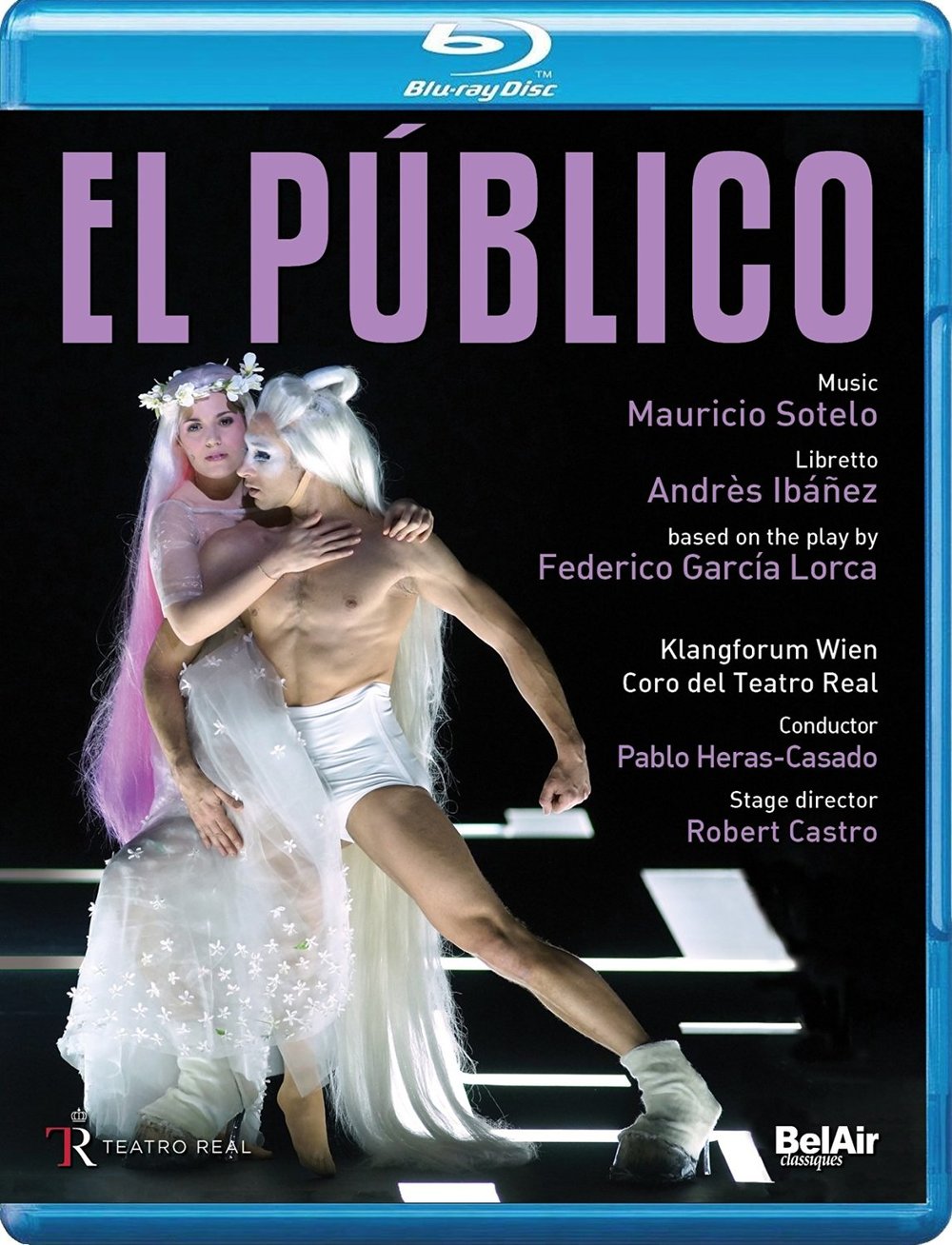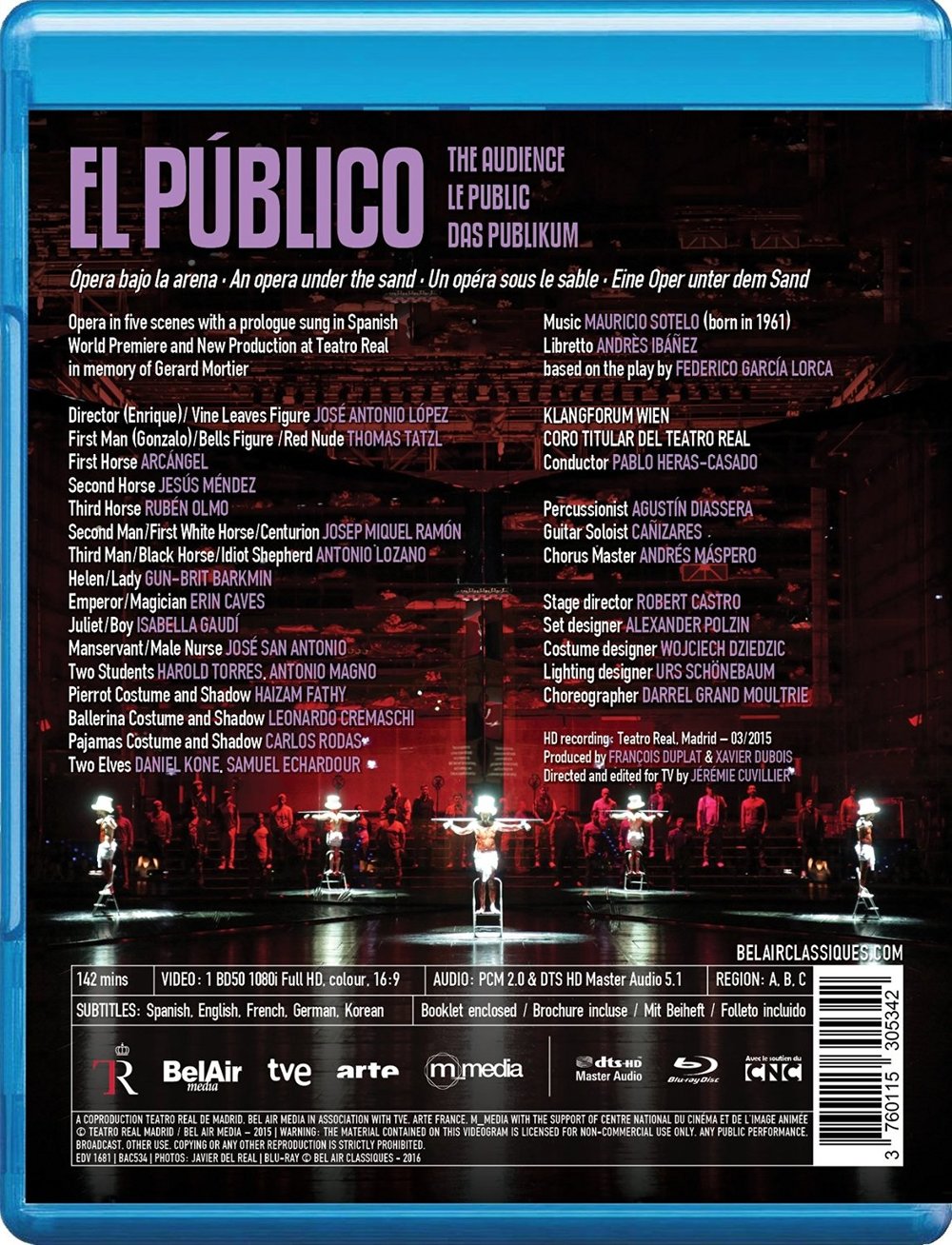

Mauricio Sotelo El público (The Audience) opera to a libreto by Andrès Albáñez based on a play by Fredrico García Lorca. Directed 2015 by Robert Castro. Stars José Antonio Lópes (Director (Enrique) / Vine Leaves Figure), Thomas Tatzl (First Man (Gonzalo))/Bells Figure/Red Nude), Arcángel (First Horse), Jesús Méndez (Second Horse), Rubén Olmo (Third Horse), Josep Miquel Ramón (Second Man/First White Horse/Centurion), Antonio Lozano (Third Man/Black Horse/Idiot Shepherd), Gun-Brit Barkmin (Helen/Lady), Erin Caves (Emperor/Magician), Isabella Gaudí (Juliet/Boy), José San Antonio (Manservant/Male Nurse), Harold Torres and Antonio Magno (Two Students), Haizam Fathy (Pierrot Costume and Shadow), Leonardo Tremaschi (Ballerina Costume and Shadow), Carlos Rodas (Pajamas Costume and Shadow), and Daniel Kone & Samuel Echardour (Two Elves). Pablo Heras-Canado conducts the Klangforum Wien and the Coro Titular of the Teatro Real (Andrés Máspero Chorus Master). Special instrumental guests are guitar soloist Cañizares and percussionist Agustín Daissera. Sets by Alexander Polzin; costumes by Wojciech Dziedzic; lighting by Urs Schönebaum; choreography by Darrel Grand Moultrie. Directed for TV by Jérémie Cuvillier; produced by François Duplat and Xavier Dubois. Sung in Spanish. Released 2016, disc has 5.1 dts-HD Master Audio sound. Grade: B- with the ‽ designation.
Lorca (1898 to 1936), perhaps Spain's most celebrated 20th century poet and dramatist, was from wealthy, conservative roots. But he was also gay. So he fell in with the Spanish avant-garde and surrealists who gave him a platform to criticize bourgeois conventions. In 1936 he was murdered, it seems, by a Falangist death squad. Although folks are still looking, his remains have not been found. He wrote in 1930 a stage play called El público. When Lorca died, there were two unpublished manuscripts of El público known to exist. They went missing during the Spanish Civil War; although folks are still looking, they have not been found. But an earlier draft of much of the play did turn up.
Wildly symbolic and surreal, the play has seldom been produced. Doing El público remains, I surmise, the ultimate unattainable dream for Spanish stage directors. So it was probably not a surprise when Gerard Mortier (1943-2014) scheduled El público in opera form, which turned out to be his last major decision as artistic director in Madrid. Mortier was, of course, the "visionary opera company leader whose bold theatricality and updating of the canon helped define the art form’s modern history" (Zachary Woolfe in the New York Times after Mortier's death).
Although Mortier wasn't at Madrid very long, he kissed the sleeping beauty and gave us the amazing C(H)ŒURS show as well as The Perfect American, Brokeback Mountain, and the spooky Les Contes D'Hoffmann. Even though his short tour at Madrid was full of controversy, it seems that everyone started missing him as soon as he was dead. So I expect everyone went all out in the effort to make this El público as impressive as possible.
Because we have only fragments of what was to be a surreal and allegorical work, the El público opera is disjointed and often puzzling. Let’s jump right into screenshots (I often can’t accurately name many of the artists). There is a short Prologue with an Idiot Shepherd (Antonia Lozano) and two boys (or elves) paying the roles of sheep (Daniel Kone and Samuel Echardour ). There are many characters in the opera; some have masks and only a few have names:
Mauricio Sotelo’s score for this is absorbing and beautiful; it’s played masterfully by the Klangforum Wien (Vienna Sound Forum). Because of the important flamenco influence, the guitarist Cañizares is perched high and close to the audience:
One named character is the theater director Enrique (Henry). Enrique is a symbol of the old-fashion theater based on bourgeois morality and conventions—the theater of open air. Enrique has just finished a successful production of Romeo and Juliet, archetypal traditional theater fare with a man and a woman in love. The horses glaring at Enrique—more about them later—are expression of Enrique’s disquietude with his success. For Enrique is gay:
The name of this play in English is “The Audience.” Even the audience is tired of traditional art represented by Shakespearean. Aggressive members of the audience suggest it is time for dramas that go deeper and deal with darker and obscured issues: the “theater under the sand.” This is a poor translation into English. The man in the white hat below is asking for “underground theater.” The man in the black jacket agrees: he is Gonzalo, Enrique’s secret lover. What we are seeing here are opening salvos in the battle of the sexual revolution. As quaint as it seems today, it was the kind of thing that could get you killed in Spain 90 years ago (2020-1930=90):
Poor Enrique is in agony: if he goes underground, will enough of the audience follow him:
Even the organization of the libretto of El público is confusing. The easiest way to follow the action is to break this up into 5 numbered parts (after the short prologue). We are still in Part One, which is called the “Folding Screen.” Anyone who passes behind the screen is transformed into whatever his secret desire might be. Next below Gonzalo turns into a woman who wants to embroider something:
Enrique also calls on his wife for support: she is Helen, shown as a symbol for traditional propriety:
So at this point the playwright has presented us with tension between the traditional view of society “above ground” with clearly defined roles for men and women and the underground view that human sexuality is more complicated than that. We now move into Part Two, called “The Ruin.” This part suggests the many ways damage is done psychologically when people are not allowed to express their true identities in rational ways. Even the most powerful man on earth, the Roman emperor (Erin Caves), falls victim. This leads to images that, while not pornographic, are best not shown here for fear of causing false alarms with AI screening systems:
Now we move into Part Three, “The Theater under the Sand”, or, better perhaps, “The Underground Theater.” Suddenly the producers shift into trick photography. The large hovering image is conductor Pablo Heras-Casado conducting without a baton in the open air. The tiny woman is an underground-theater Juliet trying to make her way through a maze:
This Juliet is not Shakespeare’s innocent 13-year-old daughter of Lord Capulet:
There are a number of horses of different types to entertain Juliet, including one that is a hell of a dancer in the flamenco style. I think credit for the dancer goes to “Arcángel.” I tried to find out more about Arcángel on the Internet. I learned there are many artists using that name including a famous flamenco singer, but I couldn’t drum up information about the dancer:
This is a view of the fabulous horse dancing (true flamenco lovers might object to this):
The climax of the Underground Theather is the dance of the costumes. The dancer here is not appearing in “blackface.” On a dark stage, you would only see the tutu moving about:
Now we move on to Part Four or “The Revolution.” Or maybe it should be called “The Counter-revolution.” The Director casts Juliet as a boy, and the public revolts:
This is the end of Gonzalo, who inspired Enrique to go on the Underground Theater adventure. Maybe Gonzalo is really Lorca, who foresaw in 1930 his murder in 1936:
Students argue about the open air versus the underground:
From Part Five, “The cold.” Gonzalo is dead. The director lives on, alone, and cold:
The librettist Andrès Albáñez is a serious author with many publications. He states that his task was to organize the text, but the words are those of Lorca. Mauricio Sotelo has recordings on YouTube of such things a a sonata written for Alfed Brendel and the most amazing, long, and elevated concerto you could image for violin, flamenco dancer, and percussionist. The Klargforum Wien (Vienna Sound Forum) is a dead-serious modern-music chamber orchestra that has close connections to Sotelo. Because the source was fragments of a draft play, the opera itself is disjointed and incomplete. I think the Teatro Real did an excellent job of presenting the fragments. PQ and SQ are fine. For most fine-arts fans this is a C+ title. For fans of Spanish arts in the 20th-21st century, this would be a B+ title. I’m going to give this the single grade of B- with the ‽ warning that would not want to buy this unless you know what you are getting into.
OR



















